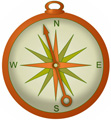Quilt No.753PHM - Powerhouse Museum
The maker was Miss Ethel Kirsop who lived in Chatswood Sydney. The quilt was commenced c.1944 and took about 8 years to complete. Ethel Kirsop gave the quilt to the Powerhouse Museum in 1980. It is used for research and exhibition purposes only.
"Ethel Kirsop was a resident of Chatsood for many years and a patron of the Australian Federation of Business and Professional Women Incorporated. A special award was established called the Ethel Kirsop Memorial Award, to provide support for a post-graduate female student of political journalism." [PHM]
When Ethel Kirsop gave her quilt to the Powerhouse Museum in 1980, she wrote the following statement:
"First saw a patchwork quilt in 1930s - two made by Women's Institute in England for Princesses Elizabeth and Margaret. Learned history of quilt making. Quilt is of half inch hexagons. It is estimated (by a mathematician friend) to be made of 7300 (+) hexagons. I set out to show design in a quilt rather than haphazard squares. It is entirely hand stitched. It was made over a period of 8 years, although not continuously worked on.
"Front is made entirely of scrap material. The main colour scheme ie centre and corners were off-cuts from dresses, dressing gowns made in a small factory owned by a friend. The rest of medallions are scraps from my friends' dresses - all my friends can recognise their dresses even now.
"The unbleached calico background is made entirely from scraps remaining after parcels for soldier friends (Middle East and New Guinea) had been sewn in calico (as was the practice) and later food parcels for relatives in Britain.
"Templates of brass were used - papers cut from old used shorthand books (ideal texture). When tacking was removed papers did not fall out as expected and had to be removed individually!!
"Expected to back the quilt with a standard unbleached sheet, I still had some ration coupons but found I had made the quilt too long. I wrote to the Actil Company and they very kindly cut a piece of sheeting to the correct size - no charge, still wartime restrictions, no coupons. I had this dyed pale blue and blind stitched the quilt to the backing.
"By this time friends had persuaded me to enter it in the Royal Sydney Show. Two days before the quilt had to be taken to the Showground for exhibition I finished the stitching and found to my horror that the front sagged away from the back.
"It was then I had to purchase the only bought material used - the rosette and diamond on the back - bought at (then) Farmers with my coupons - made in 2 nights - stitched through to the front to hold it and next morning met the deadline at the Showground.
"The quilt was exhibited in the first Royal Agricultural Show held after World War II, 4th/15th April 1952 and won first prize. An article on it was written in the Sydney Morning Herald.
"The Ku-Ring-Gai Agricultural Scty wrote to me and asked me to exhibit and also gave it 1st prize. It was also exhibited at two or three private exhibitions, but I ceased to do so because the Public were inclined to soil it and even pull patches apart."
[Ethel Kirsop for the Powerhouse Museum, 1980]
Related Quilts:
2109 X 1727mm
2200 x 1900mm
1270 x 1160mm
935 x 635mm
1940 x 1540mm
1735 x 1350mm






